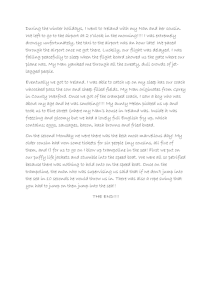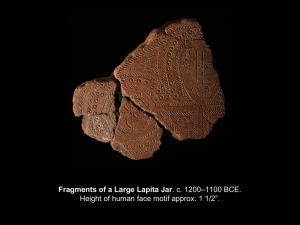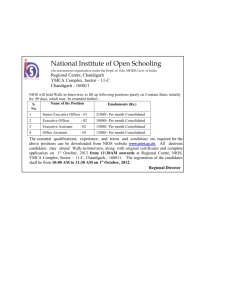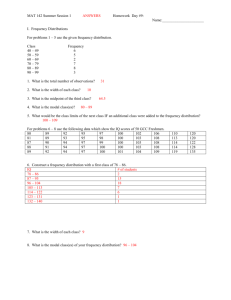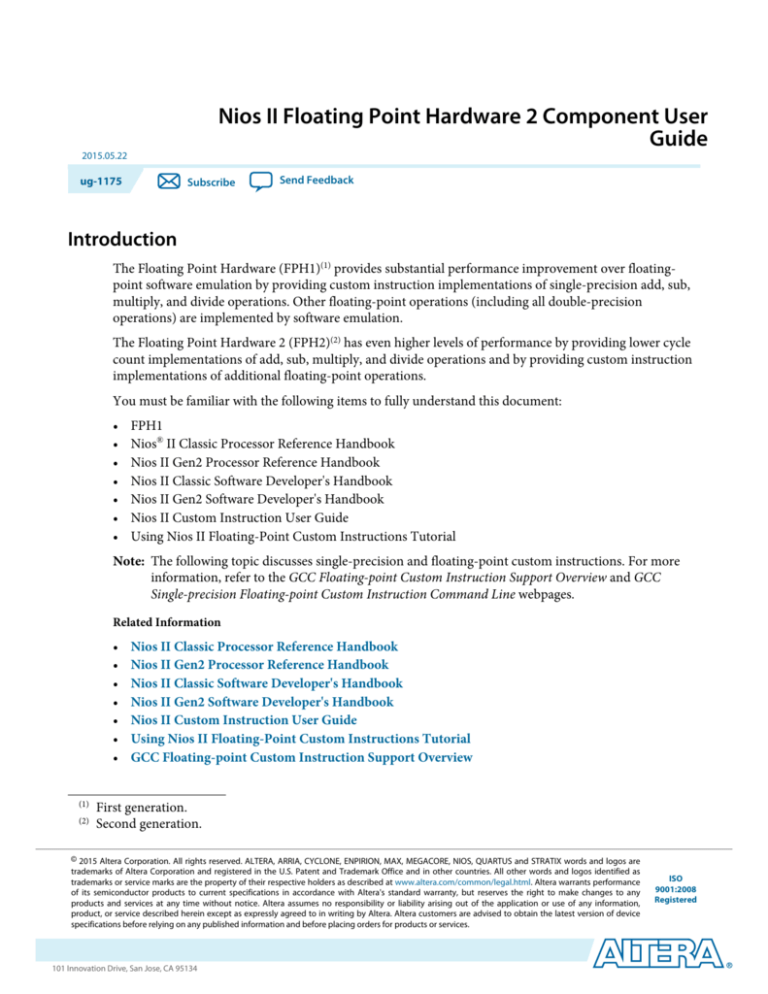
Nios II Floating Point Hardware 2 Component User
Guide
2015.05.22
ug-1175
Subscribe
Send Feedback
Introduction
The Floating Point Hardware (FPH1)(1) provides substantial performance improvement over floatingpoint software emulation by providing custom instruction implementations of single-precision add, sub,
multiply, and divide operations. Other floating-point operations (including all double-precision
operations) are implemented by software emulation.
The Floating Point Hardware 2 (FPH2)(2) has even higher levels of performance by providing lower cycle
count implementations of add, sub, multiply, and divide operations and by providing custom instruction
implementations of additional floating-point operations.
You must be familiar with the following items to fully understand this document:
•
•
•
•
•
•
•
FPH1
Nios® II Classic Processor Reference Handbook
Nios II Gen2 Processor Reference Handbook
Nios II Classic Software Developer's Handbook
Nios II Gen2 Software Developer's Handbook
Nios II Custom Instruction User Guide
Using Nios II Floating-Point Custom Instructions Tutorial
Note: The following topic discusses single-precision and floating-point custom instructions. For more
information, refer to the GCC Floating-point Custom Instruction Support Overview and GCC
Single-precision Floating-point Custom Instruction Command Line webpages.
Related Information
•
•
•
•
•
•
•
(1)
(2)
Nios II Classic Processor Reference Handbook
Nios II Gen2 Processor Reference Handbook
Nios II Classic Software Developer's Handbook
Nios II Gen2 Software Developer's Handbook
Nios II Custom Instruction User Guide
Using Nios II Floating-Point Custom Instructions Tutorial
GCC Floating-point Custom Instruction Support Overview
First generation.
Second generation.
© 2015 Altera Corporation. All rights reserved. ALTERA, ARRIA, CYCLONE, ENPIRION, MAX, MEGACORE, NIOS, QUARTUS and STRATIX words and logos are
trademarks of Altera Corporation and registered in the U.S. Patent and Trademark Office and in other countries. All other words and logos identified as
trademarks or service marks are the property of their respective holders as described at www.altera.com/common/legal.html. Altera warrants performance
of its semiconductor products to current specifications in accordance with Altera's standard warranty, but reserves the right to make changes to any
products and services at any time without notice. Altera assumes no responsibility or liability arising out of the application or use of any information,
product, or service described herein except as expressly agreed to in writing by Altera. Altera customers are advised to obtain the latest version of device
specifications before relying on any published information and before placing orders for products or services.
www.altera.com
101 Innovation Drive, San Jose, CA 95134
ISO
9001:2008
Registered
2
ug-1175
2015.05.22
Overview
• GCC Single-precision Floating-point Custom Instruction Command Line
Overview
The "Custom Instruction Implementation" figure shows the structure of the FPH2 component. The
component is packaged as one Qsys component with the display name Floating Point Hardware 2 and
the name altera_nios_custom_instr_floating_point_2. The component is composed of the following
two custom instruction components:
• altera_nios_custom_instr_floating_point_2_combi
• altera_nios_custom_instr_floating_point_2_multi
Figure 1: Custom Instruction Implementation
This figure lists the floating-operations implemented by each custom instruction.
The characteristics of the FPH2 are:
• Supports FPH1 operations (add, sub, multiply, divide) and adds support for square root, comparisons,
integer conversions, minimum, maximum, negate, and absolute
• Single-precision floating-point values are stored in the Nios II general purpose registers
• VHDL only
• Qsys support only
• Single-precision only
• Optimized for FPGAs with 4-input LEs and 18-bit multipliers
Altera Corporation
Nios II Floating Point Hardware 2 Component User Guide
Send Feedback
ug-1175
2015.05.22
Resources
3
• GCC and Nios II SBT (Software Build Tools) software support
• IEEE 754-2008 compliant except for:
• Simplified rounding
• Simplified NaN handling
• No exceptions
• No status flags
• Subnormal supported on a subset of operations
• Binary-compatibility with FPH1
• FPH1 implements Round-To-Nearest rounding. Because FPH2 implements different rounding,
results might be subtly different between the two generations
Resources
The resource utilization by the FPH2 are as follows:
• ~2500 4-input LEs
• Nine 9-bit multipliers
• Three M9K memories or larger
Using the FPH2 in Qsys
To use the FPH2 in Qsys, you must find the component called “Floating Point Hardware 2” in the Project
area of the Component Library. The FPH2 component is located under the “Embedded Processors” group
in the Component Library.
The "Qsys Screenshot" figure shows a screenshot of Qsys with Nios II connected to the FPH2. The FPH2
has two slaves (s1 and s2). One slave is for the combinatorial custom instruction and the other slave is for
the multi-cycle custom instruction. Connect both slaves to the Nios II custom_instruction_master by
clicking the dot in the connections patch panel. The following figure shows how it should look.
Figure 2: Qsys Screenshot
After connecting the FPH2 to the Nios II, generate in Qsys as you normally would and then use Quartus®
to compile the generated RTL or use an RTL simulator, like Modelsim™, to perform simulations.
Related Information
Quartus II Handbook Volume 1: Design and Synthesis
Nios II Floating Point Hardware 2 Component User Guide
Send Feedback
Altera Corporation
4
ug-1175
2015.05.22
Floating-Point Background
Floating-Point Background
For a better understanding of the FPH2, this section provides background information about floatingpoint.
Note: The following topic discusses single-precision and floating-point custom instructions. For more
information, refer to the GCC Floating-point Custom Instruction Support Overview and GCC
Single-precision Floating-point Custom Instruction Command Line webpages.
Related Information
• GCC Floating-point Custom Instruction Support Overview
• GCC Single-precision Floating-point Custom Instruction Command Line
IEEE 754 Format
The "Single-Precision Format" figure shows the fields in an IEEE 754 32-bit single-precision value and the
"Single-Precision Field Descriptions" table provides a description of the fields. Normal single-precision
floating-point numbers have the value (-1)S * 1.FRAC * 2EXP -127.
Figure 3: Single-Precision Format
Table 1: Single-Precision Field Descriptions
Mnemonic
Name
Description
FRAC
Fraction
Specifies the fractional portion (right of the binary point) of the
mantissa. The integer value (left of the binary point) is always
assumed to be 1 for normal values so it is omitted. This omitted
value is called the hidden bit. The mantissa ranges from ≥1.0 to
<2.0.
EXP
Biased Exponent
Contains the exponent biased by the value 127. The biased
exponent value 0x0 is reserved for zero and subnormal values.
The biased exponent value 0xff is reserved for infinity and NaN.
The biased exponent ranges from 1 to 0xfe for normal numbers
(-126 to 127 when the bias is subtracted out).
S
Sign
Specifies the sign. 1 = negative, 0 = positive. Normal values, zero,
infinity, and subnormals are all signed. NaN has no sign so the S
field is either 0 or 1 and is ignored.
The IEEE 754 standard provides the following special values:
•
•
•
•
Altera Corporation
Zero (EXP=0, FRAC=0)
Subnormal (EXP=0, FRAC≠0)
Infinity (EXP=255, FRAC=0)
NaN (EXP=255, FRAC≠0)
Nios II Floating Point Hardware 2 Component User Guide
Send Feedback
ug-1175
2015.05.22
Unit in the Last Place
5
Note: Zero, subnormal, and infinity are signed as specified by the S field. NaN has no sign so the S field is
ignored.
Unit in the Last Place
A unit in the last place (ulp) is 2-23 which is approximately 1.192093e-07. The ulp is the distance
between the closest straddling floating-point numbers a and b (a ≤ x ≤ b, a ≠ b) assuming that the
exponent range is not upper-bounded. The IEEE Round-to-Nearest modes produce results with a
maximum error of one-half ulp. The other IEEE rounding modes (Round-to-Zero, Round-to-PositiveInfinity, and Round-to-Negative-Infinity) produce results with a maximum error of one ulp.
Encoding of Values
The "Encoding of Values" table shows how single-precision values are encoded across the 32-bit range
from 0x0000_0000 to 0xffff_ffff. The precision ρ for single precision is 24 (23 bits in FRAC plus one
hidden bit), the radix β is 2, emin is -126, emax is 127. The most-significant bit of FRAC is 0 for signaling
NaNs (sNaN) and 1 for quiet NaNs (qNaN).
Table 2: Encoding of Values
Hexadecimal
Value
Name
S
EXP
FRAC
Decimal Value
+0
0
0x00
0x00_0000
0x0000_
0001
min pos
subnormal
0
0x00
0x00_0001
0x007f_
ffff
max pos
subnormal
0
0x00
0x7f_ffff
min pos normal 0
0x01
0x00_0000
1
0
0x7f
0x00_0000
1.0 (1.0x20)
2
0
0x80
0x00_0000
2.0 (1.0x21)
max pos
normal
0
0xfe
0x7f_ffff
+∞
0
0xff
0x00_0000
0xff
0x00_0001
0xff
0x3f_ffff
0xff
0x40_0000
0x0000_
0000
0x0080_
0000
0x3f80_
0000
0x4000_
0000
0x7f7f_
ffff
0x7f80_
0000
0x7f80_
0001
min sNaN (pos 0
sign)
0x7fdf_
ffff
max sNaN (pos 0
sign)
0x7fe0_
0000
min qNaN (pos 0
sign)
Nios II Floating Point Hardware 2 Component User Guide
Send Feedback
0.0
1.40129846e–45
(βemin-ρ+1 = 2-126-24+1
= 2-149)
1.1754942e-38
1.17549435e–38
(βemin = 2-126)
3.40282347e+38 ((β
– β1- ρ) * 2emax = (2 –
21-24) * 2127 = (2 –
223) * 2127
Altera Corporation
6
ug-1175
2015.05.22
Rounding Schemes
Hexadecimal
Value
0x7fff_
ffff
Name
S
max qNaN (pos 0
sign)
EXP
FRAC
0xff
0x7f_ffff
Decimal Value
-0
1
0x00
0x00_0000
-0.0
0x8000_
0001
max neg
subnormal
1
0x00
0x00_0001
-1.40129846e–45
0x807f_
ffff
min neg
subnormal
1
0x00
0x7f_ffff
-1.1754942e-38
0x8080_
0000
max neg
normal
1
0x01
0x00_0000
-1.17549435e–38
0xff7f_
ffff
min neg
normal
1
0xfe
0x7f_ffff
-3.40282347e+38
-∞
1
0xff
0x00_0000
0xff
0x00_0001
0xff
0x3f_ffff
0xff
0x40_0000
0xff
0x7f_ffff
0x8000_
0000
0xff80_
0000
0xff80_
0001
max sNaN (neg 1
sign)
0xffdf_
ffff
min sNaN (neg 1
sign)
0xffe0_
0000
max qNaN (neg 1
sign)
0xffff_
ffff
min qNaN (neg 1
sign)
In summary the order of values from 0x0000_0000 to 0xffff_ffff is as follows:
•
•
•
•
•
•
•
•
•
•
+0
+subnormal
+normal
+∞
+NaN
-0
-subnormal
-normal
-∞
-NaN
Rounding Schemes
The result of an operation on floating-point numbers may not be exactly represented as a floating-point
value so it has to be rounded.
The IEEE 754-2008 standard defines the default rounding mode to be “Round-to-Nearest RoundTiesTo‐
Even”. In the IEEE 754-1985 standard, this was called “Round-to-Nearest-Even”. Both standards also
define additional rounding modes called “Round-to-Zero”, “Round-to-Negative-Infinity”, and “Round-
Altera Corporation
Nios II Floating Point Hardware 2 Component User Guide
Send Feedback
ug-1175
2015.05.22
Nearest Rounding
7
to-Positive-Infinity”. The IEEE 754-2008 standard introduced a new optional rounding mode called
“Round-to-Nearest RoundTiesAway”.
The FPH2 operations either support Nearest Rounding (RoundTiesAway), Truncation Rounding, or
Faithful Rounding. The type of rounding is a function of the operation and is specified in Table 4-2.
Because the software emulation library (used when FPH operations aren’t provided) and FPH1
implement Round-to-Nearest RoundTiesToEven, there can be differences in the results between FPH2
and these other solutions.
Nearest Rounding
Nearest Rounding corresponds to the IEEE 754-2008 “Round-to-Nearest RoundTiesAway” rounding
mode. Nearest Rounding rounds the result to the nearest single-precision number. When the result is
halfway between two single-precision numbers, the rounding chooses the upper number (larger values for
positive results, smaller value for negative results).
The maximum error of Nearest Rounding is one-half ulp. Errors are not evenly distributed because the
upper number is chosen more often than the lower number for randomly distributed results.
Truncation Rounding
Truncation Rounding corresponds to the IEEE 754-2008 “Round-To-Zero” rounding mode. Truncation
Rounding rounds results to the lower nearest single-precision number.
The maximum error of Truncation Rounding is one ulp. Errors are not evenly distributed.
Faithful Rounding
Faithful Rounding is not an IEEE 754 defined rounding mode. Faithful Rounding rounds results to either
the upper or lower nearest single-precision numbers. So, the result produced is either one of two possible
values and the choice between the two is not defined.
The maximum error of Faithful Rounding is one ulp. Errors are not guaranteed to be evenly distributed.
Rounding Examples
The "Decimal Rounding Examples" table shows examples of the supported rounding schemes for decimal
values assuming rounded normalized decimal values with two digits of precision, like one-digit integer or
one-digit fraction.
Table 3: Decimal Rounding Examples
Unrounded Value
Nearest Rounding
Truncation Rounding
Faithful Rounding
3.34
3.3
3.3
3.3 or 3.4
6.45
6.5
6.4
6.4 or 6.5
2.00
2.0
2.0
2.0 or 2.1
8.99
9.0
8.9
8.9 or 9.0
-1.24
-1.2
-1.2
-1.2 or -1.3
-3.78
-3.8
-3.7
-3.7 or -3.8
Nios II Floating Point Hardware 2 Component User Guide
Send Feedback
Altera Corporation
8
ug-1175
2015.05.22
Special Cases
Special Cases
The "Special Cases" table lists the results of some IEEE 754 special cases. The value ‘x’ is a normal value.
The FPH2 are compliant for all of these cases.
Results are assumed to be correctly signed so signs are omitted when they are not important. When the
sign is relevant, signs are shown with extra parenthesis around the value such as (+∞). The value x in the
table is any non-NaN value.
Comparisons ignore the sign of zero for equality. For example, (-0) == (+0) and (+0) ≤ (-0). Comparisons
that don’t include equality, like > and <, don’t consider -0 to be less than +0. Comparisons return false if
either or both inputs are NaN. The min and max operations return the non-NaN input if one of their
inputs is NaN and the other is non-NaN. Other operations that produce floating-point results return NaN
if any or all of their inputs are NaN.
Table 4: Special Cases
Operation
Special Cases
fdivs
0/0=NaN
∞/∞=NaN
0/∞=0, ∞/0=∞ NaN/x=NaN, x/NaN=NaN,
NaN/NaN=NaN
fsubs
(+∞)-(+∞)=NaN
(-∞)-(-∞)=NaN
(-0)-(-0)=+0
fadds
(+∞)+(-∞)=NaN
(-∞)+(+∞)=NaN
(+0)+(-0)=+0, NaN+x=NaN, x+NaN=NaN,
(-0)+(+0)=+0 NaN+NaN=NaN
fmuls
0*∞=NaN
∞*0=NaN
NaN*x=NaN, x*NaN=NaN,
NaN*NaN=NaN
fsqrts
sqrt(-0) =-0
sqrt(x) =NaN, x<0
sqrt(NAN) =NaN
fixsi & round
int(>231-1)=
0x7fffffff, int(+∞)
=0x7fffffff
int(<-231)=
x80000000, int(∞)=0x80000000
int(NaN)=undefined
fmins
min((+0),(-0))=(0)
min((-0),(+0))=(0)
min(NaN,n)=x, min(x,NaN)
=x, min(NaN,NaN)=NaN,
min(+∞,x)=x, min(-∞,x)=-∞
fmaxs
max((+0),(-0))
=(+0)
max((-0),(+0))
=(+0)
max(NaN,x)=x, max(x,NaN)
=x, max(NaN,NaN)=NaN,
max(+∞,x)=+∞, max(-∞,x)=x
fcmplts (<)
(+∞)<(+∞)=0
(-∞)<(-∞)=0
(-0)<(+0)=0,
(+0)<(-0)=0
fcmples (≤)
(+∞)≤(+∞)=1
(-∞)≤(-∞)=1
(+0)≤(-0)=1, (- NaN≤x=0, x≤NaN=0,
0)≤(+0)=1
NaN≤NaN=0
fcmpgts (>)
(+∞)>(+∞)=0
(-∞)>(-∞)=0
(-0)>(+0)=0,
(+0)>(-0)=0
NaN>x=0, x>NaN=0, NaN>
NaN=0
fcmpges (≥)
(+∞)≥(+∞)=1
(-∞)≥(-∞)=1
(-0)≥(+0)=1,
(+0)≥(-0)=1
NaN≥x=0, x≥NaN=0,
NaN≥NaN=0
fcmpeqs (=)
(+∞)=(+∞)=1
(-∞)=(-∞)=1
(-0)=(+0)=1
(NaN==x)=0, (x==NaN)=0,
(NaN==NaN)=0
Altera Corporation
NaN-x=NaN, x-NaN=NaN,
NaN-NaN=NaN
NaN<x=0, x<NaN=0,
NaN<NaN=0
Nios II Floating Point Hardware 2 Component User Guide
Send Feedback
ug-1175
2015.05.22
Feature Description
Operation
fcmpnes (≠)
9
Special Cases
(+∞)≠ (+∞)=0
(-∞)≠ (-∞)=0
(-0)≠(+0)=0
NaN≠x=0, x≠NaN=0,
NaN≠NaN=0
Feature Description
The FPH2 are implemented with one combinatorial custom instruction and one multi-cycle custom
instruction. The combinatorial custom instruction implements the comparison, minimum, maximum,
negate, and absolute operations. The multi-cycle custom instruction implements the add, subtract,
multiply, divide, square root, and conversion operations.
Note: All operations are required. There are no configurable options.
IEEE 754 Compliance
The FPH2 are compliant with the IEEE 754-2008 standard except for the following:
• No traps/exceptions.
• No status flags.
• Remainder and conversions between binary and decimal operations are not supported. These are
provided by the software emulation library.
• Round-to-nearest-even not supported. Instead, Nearest Rounding, Truncation Rounding, or Faithful
Rounding (depending on the operator) is supported.
• Subnormals are not supported by add, subtract, multiply, divide, square root, and float2integer
conversion operations. Subnormal inputs are treated as signed zero and subnormal outputs are never
created (result is signed zero instead). This treatment of subnormal values is known in the industry as
flush-to-zero.(3)
• Subnormals cannot be created by the integer2float conversation operation. This behavior is IEEE 754
compliant and is listed here for completeness.
• No distinction is made between signaling and quiet NaNs as input operands. Any result that produces
a NaN may produce either a signaling or quiet NaN.
• A NaN result with one or more NaN input operands is not guaranteed to return any of the input NaN
values; the NaN result can be a different NaN than the input NaNs.
Exception Handling
The FPH2 does not support exceptions. Instead, a specific result is created. The "IEEE 754 Exception
Cases" table shows the FPH2 results created for operations that would trigger an IEEE 754 exception.
Table 5: IEEE 754 Exception Cases
IEEE 754 Exception
(3)
FPH2 Result
Invalid
NaN
Division by zero
Signed infinity
Overflow
Signed infinity
Subnormals are supported by comparison, minimum, maximum, comparison, negate, and absolute
operations so these are IEEE 754-2008 compliant.
Nios II Floating Point Hardware 2 Component User Guide
Send Feedback
Altera Corporation
10
ug-1175
2015.05.22
Operations
IEEE 754 Exception
FPH2 Result
Underflow
Signed zero
Inexact
Normal number
Operations
The "FPH2 Operation Summary" table provides a detailed summary of the FPH2 operations. The values
“a” and “b” are assumed to be single-precision floating-point values. The following list provides detailed
information about each column:
• Operation(4)—Provides the name of the floating-point operation. The names match the names of the
corresponding GCC FPH command-line options except for “round” which has no GCC support.
• N—Provides the 8-bit fixed custom instruction N value for the operation. The FPH2 use fixed N values
that occupy the top 32 Nios II custom instruction N values (224 to 255). The FPH1 also use fixed N
values (252 to 255) and the FPH2 assign the same operations to those N values to maintain compati‐
bility.
• Cycle(5)—Specifies the number of cycles it takes to execute the instruction. A combinatorial custom
instruction takes 1 cycle. A multi-cycle custom instruction is always at least 2 cycles. An N cycle multicycle custom instruction has N-2 register stages inside the custom instruction because the Nios II
registers the result from the custom instruction and also allows another cycle for g wire delays in the
source operand bypass multiplexers. The Cycle column doesn’t include the extra cycles (maximum of
2) that an instruction following the multi-cycle custom instruction is stalled by the Nios II/f if the
instruction uses the result within 2 cycles. These extra cycles are because multi-cycle instructions are
late result instructions.
• Result—Describes the computation performed by the operation.
• Subnormal—Describes how the operation treats subnormal inputs and subnormal outputs.
• Rounding(6)—Describes how the result is rounded. The possible choices are Nearest, Truncation,
Faithful, and none.
• GCC Inference—Shows the C code that infers the custom instruction operation.
Table 6: FPH2 Operation Summary
Operation
(4)
(5)
(6)
(7)
N
Cycles
Result
Subnormal
Rounding
GCC Inference
fdivs
255
16
a/b
flush-to-0
Nearest
a/b
fsubs
254
5
a-b
flush-to-0
Faithful
a-b
fadds
253
5
a+b
flush-to-0
Faithful
a+b
fmuls
252
4
a*b
flush-to-0
Faithful
a*b
fsqrts
251
8
sqrt(a)
flush-to-0
Faithful
sqrtf()
For more information, refer to the "-mcustom-<operation>" chapter.
For more information, refer to one of the Nios II Processor Reference Handbooks.
For more information, refer to the "Rounding Schemes" chapter. A rounding of “none” means that the result
doesn’t have to be rounded.
Nios II GCC 4.7.3 is not able to reliably replace calls to Newlib floating-point functions with the
equivalent custom instruction even though it has –mcustom-<operation> command-line options and
pragma support for these. Instead, the custom instruction must be invoked directly using the __builtin_
custom_* facility of GCC. The FPH2 include a C header file that provides the required #define macros to
invoke the custom instruction directly. You should include this header file in your C source files.
Altera Corporation
Nios II Floating Point Hardware 2 Component User Guide
Send Feedback
ug-1175
2015.05.22
Software Issues
Operation
N
Cycles
Result
Subnormal
Rounding
11
GCC Inference
floatis
250
4
int_to_
float(a)
Does not
apply
Does not
apply
Casting
fixsi
249
2
float_to_
int(a)
flush-to-0
Truncation
Casting
round
248
2
float_to_
int(a)
flush-to-0
Nearest
lroundf()(7)
reserved
234 to 247
Undefined
undefined
fmins
233
1
(a<b) ? a : b
supported
None
fminf()(7)
fmaxs
232
1
(a<b) ? b : a
supported
None
fmaxf()(7)
fcmplts
231
1
(a<b) ? 1 : 0
supported
None
a<b
fcmples
230
1
(a≤b) ? 1 : 0
supported
None
a<=b
fcmpgts
229
1
(a>b) ? 1 : 0
supported
None
a>b
fcmpges
228
1
(a≥b) ? 1 : 0
supported
None
a>=b
fcmpeqs
227
1
(a=b) ? 1 : 0
supported
None
a==b
fcmpnes
226
1
(a≠b) ? 1 : 0
supported
None
a!=b
fnegs
225
1
-a
supported
None
-a
fabss
224
1
|a|
supported
None
fabsf()
Note: The following topic discusses single-precision and floating-point custom instructions. For more
information, refer to the GCC Floating-point Custom Instruction Support Overview and GCC
Single-precision Floating-point Custom Instruction Command Line webpages.
Related Information
•
•
•
•
•
•
•
•
Rounding Schemes on page 6
-mcustom-<operation> on page 13
Nios II Classic Processor Reference Handbook
Nios II Gen2 Processor Reference Handbook
GCC 4.7.3 Command Line Options
Newlib Documentation page
GCC Floating-point Custom Instruction Support Overview
GCC Single-precision Floating-point Custom Instruction Command Line
Software Issues
Nios II GCC
The version of the Nios II GCC is 4.7.3 and it is used with the FPH2.
Note: The following topic discusses single-precision and floating-point custom instructions. For more
information, refer to the GCC Floating-point Custom Instruction Support Overview and GCC
Single-precision Floating-point Custom Instruction Command Line webpages.
Nios II Floating Point Hardware 2 Component User Guide
Send Feedback
Altera Corporation
12
ug-1175
2015.05.22
Inference
Related Information
• GCC 4.7.3 Command Line Options
• GCC Floating-point Custom Instruction Support Overview
• GCC Single-precision Floating-point Custom Instruction Command Line
Inference
GCC is able to infer most FPH2 operations from C source code. The "FPH2 Operation Summary" table in
the "Operations" chapter lists all the operations and shows how the FPH2 are inferred.
Note: GCC does not infer Newlib math functions. These functions can be replaced with their equivalent
custom instruction using the __builtin_custom_* facility of GCC.
The altera_nios_custom_instr_floating_point_2.h C header file provides a #define macro declara‐
tion that re-defines the required Newlib () math functions to use the corresponding custom instruction
instead.
Related Information
• Operations on page 10
• altera_nios_custom_instr_floating_point_2.h on page 17
• Newlib Documentation page
Conversions
The FPH2 provide conversion operations between a signed integer type (C “short”, “int” and “long”
types) and a 32-bit single-precision (C “float” type). These conversions are inferred when GCC needs to
convert between these types, like casting. When converting between unsigned integer types and a float
type, the software emulation is used instead of the FPH2 so it is much slower.
If you do not need the extra range of positive values obtained when converting a float to an unsigned
integer directly, you can use the FPH2 and avoid using the software emulation if you modify your C code
to first cast the float type to an int type or long type and then cast to the desired unsigned integer type. For
example, instead of:
float f;
unsigned int s = (unsigned int)f; // Software emulation
use:
float f;
unsigned int s = (unsigned int)(int)f; // FPH2
The FPH2 provides two operations for converting single-precision floating-point values to signed integer
values:
• fixsi
• round
The fixsi operation performs truncation when converting a float to a signed integer. For example, fixsi
converts 4.8 to 4 and -1.5 to -1. GCC follows the C standard and invokes the fixsi operation whenever
source code uses a cast or any time that C automatically converts a float to a signed integer.
The round operation performs Nearest Rounding (tie-rounds-away) when converting a float to a signed
integer. For example, round converts 4.8 to 5 and -1.5 to -2. The round operation is invoked by calling the
custom instruction directly or using the provided #define that replaces the newlib lroundf() function.
Altera Corporation
Nios II Floating Point Hardware 2 Component User Guide
Send Feedback
ug-1175
2015.05.22
Nios II Floating-Point Options
13
Related Information
Newlib Documentation page
Nios II Floating-Point Options
GCC options that are only provided by the Nios II port of GCC are described below.
-mcustom-<operation>
The -mcustom-<operation> command-line option instructs GCC to call custom instructions instead of
using the software emulation to execute the specified operation. The -mcustom-<operation> is followed
by an equals sign and the custom instruction N value as an unsigned decimal value. The operations and
their N values are listed in the "FPH2 Operation Summary" table in the "Operations" chapter.
The -mno-custom-<operation> command-line option instructs GCC to use the software emulation to
implement the specified operation (this is the default).
Note: There is no command-line option for the round operation. These switches may be specified
multiple times on the command-line; the last one is the one that takes effect.
The following command-line options should be passed to GCC to instruct it to use all operations
provided by the FPH2 that can be inferred by GCC. For more information, refer to "Inference" chapter.
For users of the Nios II SBT, these command-line arguments are automatically added to the invocation of
GCC by the generated makefiles. For more information, refer to the "Nios II SBT" chapter.
-mcustom-fabss=224
-mcustom-fnegs=225
-mcustom-fcmpnes=226
-mcustom-fcmpeqs=227
-mcustom-fcmpges=228
-mcustom-fcmpgts=229
-mcustom-fcmples=230
-mcustom-fcmplts=231
-mcustom-fixsi=249
-mcustom-floatis=250
-mcustom-fmuls=252
-mcustom-fadds=253
-mcustom-fsubs=254
-mcustom-fdivs=255
Related Information
• Inference on page 12
• Operations on page 10
• Nios II SBT on page 17
pragmas
GCC supports pragmas located in source code files to override the -mcustom command-line options. The
pragmas affect the entire source file.
The following pragma tells GCC to call custom instruction N (where N is a decimal integer from 0 to 255)
to implement the specified floating-point operation:
#pragma GCC target(“custom-<operation>=N”)
Nios II Floating Point Hardware 2 Component User Guide
Send Feedback
Altera Corporation
14
ug-1175
2015.05.22
-mcustom-fpu-cfg
The following pragma tells GCC to use the software emulation instead of the custom instruction to
implement the specified floating-point operation:
#pragma GCC targer(“no-custom-<operation>”)
Note: There is no pragma support for the round operation.
-mcustom-fpu-cfg
This option was created for FPH1. It bundles up several command-line options into one and allows the
GCC linker to choose the pre-compiled Newlib libraries that match the bundled options.
For FPH2, the -mcustom-fpu-cfg option is not recommended. Instead it is recommended that the
individual options be used and the Newlib library be compiled from source code instead of using the precompiled Newlib libraries. This allows Newlib to obtain the benefits of all FPH2 operations that can be
inferred by GCC. However, the -mcustom-fpu-cfg option is still available and compatible with the FPH2.
The -mcustom-fpu-cfg=60-1 option is used when the FPH1 optional division is absent and is equivalent
to setting:
-mcustom-fmuls=252
-mcustom-fadds=253
-mcustom-fsubs=254
-fsingle-precision-constant
The -mcustom-fpu-cfg=60-2 option is used when the FPH1 optional division is present and is equivalent
to setting:
-mcustom-fmuls=252
-mcustom-fadds=253
-mcustom-fsubs=254
-mcustom-fdivs=255
-fsingle-precision-constant
Related Information
Newlib Documentation page
Generic Floating-Point Options
There are options provided by GCC and are not only provided by Nios II GCC. However, these options
have Nios II specific behaviors in some cases.
-fno-math-errno
From the GCC documentation:
“Do not set ERRNO after calling math functions that are executed with a single
instruction, e.g., sqrt. A program that relies on IEEE exceptions for math error
handling may want to use this flag for speed while maintaining IEEE arithmetic
compatibility.”
If -fno-math-errno is specified, GCC maps calls to sqrtf() directly to the fsqrts custom instruction.
Otherwise, GCC adds several instructions after the fsqrts custom instruction to check for a NaN result
and call the Newlib sqrtf() function if the custom instruction returns a NaN result. A NaN result occurs
when attempting the square root of a number less than -0. The Newlib sqrtf() function is called just to set
the C language errno variable. Typically embedded developers will not want this overhead on calls to
sqrtf() so it is recommended that -fno-math-errno be enabled.
Altera Corporation
Nios II Floating Point Hardware 2 Component User Guide
Send Feedback
ug-1175
2015.05.22
-fsingle-precision-constant
15
For users of the Nios II SBT, the -fno-math-errno option is set by default in the generated makefiles.
This can be overridden by setting -fmath-errno in the CPPFLAGS make variable.
The -ffinite-math-only option also eliminates the overhead of checking for NaN result for square root.
This option also has other effects and is described in the "-ffinite-math-only" chapter.
Related Information
• Nios II SBT on page 17
• -ffinite-math-only on page 15
• Newlib Documentation page
-fsingle-precision-constant
From the GCC documentation:
“Treat floating-point constants as single-precision constants instead of implicitly
converting them to double-precision constants.”
For users of the Nios II SBT, -fsingle-precision-constant is not set by default in the generated
makefiles. This is contrast to the FPH1 that set this option with the -mcustom-fpu-cfg option. The fsingle-precision-constant is not set by default in FPH2 because it can break double-precision code.
Programmers can turn on this switch if it is safe for their code. In general, casting floating-point constants
to the "float" type or appending an "f", like 3.14f are better solutions because they are localized and
independent of compiler options.
Related Information
Nios II SBT on page 17
-funsafe-math-optimizations
From the GCC documentation:
“Allow optimizations for floating-point arithmetic that (a) assume that arguments
and results are valid and (b) may violate IEEE or ANSI standards. When used at linktime, it may include libraries or startup files that change the default FPU control
word or other similar optimizations.”
This option is only required if custom instructions are used to implement the transcendental functions
(i.e. sin, cos, tan, atan, exp, and log). This option is GCC's way of saying, “I can't imagine that your
transcendental floating-point hardware is IEEE compliant, and I want you to admit this before I'll use it.”
Because transcendental functions are not included with the FPH2, the -funsafe-math-optimizations
option is not required.
-ffinite-math-only
From the GCC documentation:
“Allow optimizations for floating-point arithmetic that assume that arguments and
results are not NaNs or +-Infs.”
Programmers are recommended to experiment with this option to determine how it affects their code.
The -ffinite-math-only option also eliminates the GCC overhead created on calls to sqrtf() like –
fno-math-errno.
Nios II Floating Point Hardware 2 Component User Guide
Send Feedback
Altera Corporation
16
-fno-trapping-math
ug-1175
2015.05.22
Related Information
-fno-math-errno on page 14
-fno-trapping-math
From the GCC documentation:
“Compile code assuming that floating-point operations cannot generate user-visible
traps. These traps include division by zero, overflow, underflow, inexact result
and invalid operation. This option implies -fno-signaling-nans. Setting this option
may allow faster code if one relies on “non-stop” IEEE arithmetic, for example.”
Programmers are recommended to experiment with this option to determine how it affects their code.
-frounding-math
From the GCC documentation:
“Disable transformations and optimizations that assume default floating point
rounding behavior. This is round-to-zero for all floating point to integer
conversions, and round-to-nearest for all other arithmetic truncations. This option
should be specified for programs that change the FP rounding mode dynamically, or
that may be executed with a non-default rounding mode. This option disables
constant folding of floating point expressions at compile-time (which may be
affected by rounding mode) and arithmetic transformations that are unsafe in the
presence of sign-dependent rounding modes.”
Programmers are recommended to experiment with this option to determine how it affects their code.
Newlib Library
The Newlib library (C and math) is provided in pre-compiled and source versions. If the GCC linker is
passed the -mcustom-fpu-cfg option, it will chose a pre-compiled Newlib library with floating-point
support. The pre-compiled versions only use a subset of the FPH2 operations (namely add, subtract,
multiply, and divide) because the pre-compiled libraries were created for FPH1.
If users can meet their requirements using the available pre-compiled Newlib libraries, they are free to use
them. If not, it is recommended that users compile the Newlib libraries from source code with the same –
mcustom-<operation> options as the rest of their software.
The Newlib isgreater(), isgreaterequal(), isless(), islessequal(), and islessgreater macros
defined in math.h use the normal comparison operators (e.g. <, >=) so these macros automatically use the
FPH2 comparison operations.
The Newlib fmaxf() and fminf() functions return the maximum or minimum numeric value of their
arguments. NaN arguments are treated as missing data: if one argument is a NaN and the other numeric,
then the functions return the numeric value. The FPH2 fmaxs/fmins operations match this behavior.
Note: The following topic discusses floating-point custom instructions. For more information, refer to
the GCC Floating-point Custom Instruction Support Overview webpage.
Related Information
• -mcustom-<operation> on page 13
• pragmas on page 13
• Newlib Documentation page
Altera Corporation
Nios II Floating Point Hardware 2 Component User Guide
Send Feedback
ug-1175
2015.05.22
altera_nios_custom_instr_floating_point_2.h
17
• GCC Floating-point Custom Instruction Support Overview
For more information about the GCC Floating-point Custom Instruction Support Overview.
altera_nios_custom_instr_floating_point_2.h
This C header file provides #define macro declarations for the Newlib math library routines not reliably
replaced with custom instructions by GCC 4.7.3. C source code should include this header file to use the
custom instruction implementation of these operations.
Related Information
• GCC 4.7.3 Command Line Options
• Newlib Documentation page
Nios II SBT
The Software Build Tools (SBT) are tools used to create Altera HAL-based Board Support Packages (BSP)
and application and library makefiles for embedded software running on a Nios II. These tools come in
command-line and Eclipse GUI-based forms.
For more information about the SBT, refer to one of the Nios II Software Developer's Handbooks.
When these tools are used to generate a BSP for a Nios II with the FPH2 component connected to that
Nios II, the sw.tcl file in the component causes the BSP and any applications or libraries that use that BSP
to be aware of the presence of the FPH2. In particular, the sw.tcl performs the following functions:
• Generated makefiles pass the -mcustom-<operation> options to GCC so it knows to use the available
FPH2 operations instead of the software emulation code to implement the specified floating-point
operations.
• Generated makefiles pass the -fno-math-errno option to GCC to eliminate the overhead of detecting
NaN results and setting the errno variable for calls to sqrtf().
• Adds the file altera_nios_custom_instr_floating_point_2.h to the BSP include directory. For
more information, refer to the "altera_nios_custom_instr_floating_point_2.h" chapter.
Note: The following topic discusses floating-point custom instructions. For more information, refer to
the GCC Floating-point Custom Instruction Support Overview webpage.
Related Information
•
•
•
•
altera_nios_custom_instr_floating_point_2.h on page 17
Nios II Classic Software Developer's Handbook
Nios II Gen2 Software Developer's Handbook
GCC Floating-point Custom Instruction Support Overview
For more information about the GCC Floating-point Custom Instruction Support Overview.
Document Revision History for Nios II Floating Point Hardware 2
Component User Guide
Date
May 2015
Version
2015.05.22
Changes
Initial release.
Nios II Floating Point Hardware 2 Component User Guide
Send Feedback
Altera Corporation


